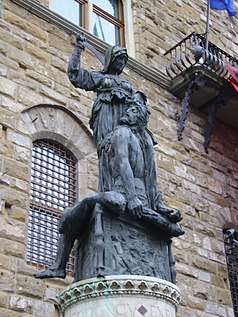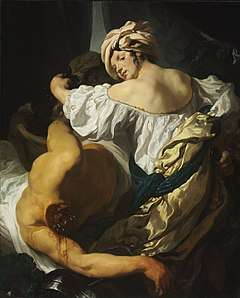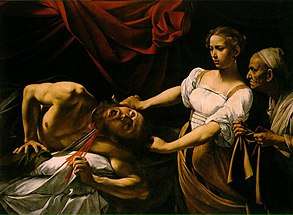Judith Slaying Holofernes (Artemisia Gentileschi, Naples)
Judith Slaying Holofernes is a painting by the Italian early Baroque artist Artemisia Gentileschi, completed in 1612-13 and now at the Museo Capodimonte, Naples, Italy.[1] It is considered one of her iconic works. The canvas shows the scene of Judith beheading Holofernes. Early feminist critics interpreted the painting as a form of visual revenge following Gentileschi's rape by Agostino Tassi in 1611; more recent analysis of the painting has taken a broader view, seeing the painting in the context of Gentileschi's achievement in portraying strong women.[2] The subject takes an episode from the apocryphal Book of Judith in the Old Testament, which recounts the assassination of the Assyrian general Holofernes by the Israelite heroine Judith. The painting shows the moment when Judith, helped by her maidservant Abra, beheads the general after he has fallen asleep drunk.
| Judith Slaying Holofernes | |
|---|---|
 | |
| Artist | Artemisia Gentileschi |
| Year | c. 1612-1613 |
| Medium | Oil on canvas |
| Dimensions | 158.8 cm × 125.5 cm ((6' 6" X 5' 4") 78.33 in × 64.13 in) |
| Location | Museo Capodimonte, Naples, Italy, Naples |
She also painted a later version of the work somewhere between 1613 and 1621, now in the Uffizi in Florence.[3][4][2]
Creation
Artemisia Gentileschi was roughly twenty years of age when she painted Judith Slaying Holofernes. Previously, Gentileschi had also completed Susanna and the Elders and Madonna and Child. These artworks already given an indication of Gentileschi's skill in representing body movement and facial expressions to express emotions. X-rays undertaken on the painting show that Gentileschi made several alterations to the painting (eg the position of Judith's arms, the position of the drapery) before it reached its current state.[5]
Subject Matter
Biblical Source
The episode of Judith beheading Holofernes is from a deuterocanonical book of the Bible. The episode is from the apocryphal Book of Judith in the Old Testament, which recounts the assassination of the Assyrian general Holofernes by the Israelite heroine Judith. Gentileschi draws upon the most climatic part of the Book of Judith where the beheading takes place.
Theme
Judith Slaying Holofernes has been considered to be related to the Power of Woman theme. Historian Susan L. Smith defines the "power of woman" as "the representational practice of bringing together at least two, but usually more, well-known figures from the Bible, ancient history or romance to exemplify a cluster of interrelated themes that include the wiles of woman, the power of love and the trials of marriage.[6] Gentileschi plays into the "wiles of woman" in her painting by literally portraying Judith at the man point of her domination of over a man. Judith is shown as a beautiful woman which enticed Holofernes and also as a fierce heroine.
Visual Analysis
The painting is relentlessly physical, from the wide spurts of blood to the energy of the two women as they perform the act.[1] The effort of the women's struggle is most finely represented by the delicate face of the maid, who is younger than in other treatements of the same theme, which is grasped by the oversized, muscular fist of Holofernes as he desperately struggles to survive. Judith Slaying Holofernes utilises deeper primary colours in comparison to the Florentine version.[7] Judith is shown wearing a cobalt blue dress with gold accents and her maidservant wears a red gown. Both woman have their sleeves rolled up. As a follower of Caravaggio, Artemisia Gentileschi makes use of chiaroscuro in the painting, with a dark background contrasting with the light shining directly on the scene of Judith beheading Holofernes.
History
Little is known of the painting's early history. There is no information as of yet on the patron of this artwork. Its location was unknown until documented in the collection of Signora Saveria de Simone in Naples in 1827.[8] At some point in the painting's history, the left and top parts of the painting were cut off, leaving a curtailed version of the original painting.[2]
Depictions of Judith
Many different artists have portrayed the biblical heroine Judith.
Renaissance

The Renaissance had a long-standing history of portraying Judith.[7] Many artists believed that the heroine Judith held many different qualities like chastity and humility.[7] Lucas Cranach the Elder painted a very straightforward version of Judith now known as Judith with the Head of Holofernes.[7] Cranach's Judith is shown with a resolved look on face as she holds a sword in her hand. She wears an ornate green dress and the viewer can only see up to her mid-thigh region. Her body is cut off due to a marble ledge were the head of Holofernes sits. There is no gushing blood and Judith seems to have made a clean cut through Holofernes head. The phlegmatic look on Judith's face reverberate the intensity of her beheading.[7] Gentileschi captures the emotions of Judith's face but maintains more medical accuracy with the blood that is spilling down the bed. Genitleschi's Judith Slaying Holofernes shows Judith in the act of beheading rather than showing her with the head of Holofernes as Cranach did.[7] Donatello also contributed his own interpretation with his sculpture known as Judith and Holofernes. In this sculpture, Judith is seen towering over Holofernes with a sword over her head. Holofernes body slumps over and his head is still attached to his body. Donatello's Judith and Holofernes sought to symbolize the theme of pride in both Holofernes and offer as a cautionary tale to the Medici family.[9] Writer Roger J. Crum notes that "Judith's gesture, pulling back the general's head, rendures sure her next blow, it also makes the neck all the more visible. Behold the neck of pride," commanded the inscription, and Donatello's treatment facilitated compliance".[9] Unlike Donatello's sculpture, Gentileschi shows Judith triumphing over Holofernes in the climatic moment of the beheading. Gentileschi also choose to show Judith without a head covering and includes Judith's maidservant.


Baroque
Judith beheading Holofernes was a very popular story amongst Baroque artists. Artemisia Gentileschi's contemporary Johann Liss stayed abreast with the Baroque style by including macabre imagery in his painting, Judith in the Tent of Holofernes. The painting shows the headless body of Holofernes slumping over. Judith sweeps Holofernes's head into a basket showing a look of swiftness about her. The viewer can see the maidservant's head in the background while the rest of her body is unseen. She seems eager to see what directions Judith will give her next.[7] The decapitated body of Holofernes has blood gushing out of it, showing Liss's interest in the human body.[7] Gentileschi has a similar urgency in her painting but shows Judith in mid-decapitation rather than showing Holofernes headless body. Gentileschi also uses the same amount of bloodiness in her painting.[7]
Caravaggio Influence
Caravaggio's Judith Beheading Holofernes shows a different portrayal of this scene. Mary Gerrard points out that Caravaggio "reintroduced a narrative emphasis, but focusing now upon the dramatic rather than the epic features of the story and upon the human conflict between the two principal characters".[5] Caravaggio shows Holofernes holding the blood coming from his neck like a string.[7] Rather than making the scene of Holofernes's beheading more palatable for the viewers, Gentileschi differs by not holding back the gruesome imagery. Gentileschi also shows Judith putting her full efforts into the slaying, even by employing her maidservant. In both Caravaggio and Gentileschi's paintings there is a notable absence of decorative detail in the background.[10]
Judith beheading Holofernes has been depicted by a number of artists including Giorgione, Titian, Rembrandt, Peter Paul Rubens and Caravaggio.
Caravaggio's Judith Beheading Holofernes is believed to be the main source of this work, and his influence shows in the naturalism and violence Gentileschi brings to her canvas.
Related paintings by Artemisia Gentileschi
Gentileschi painted another painting, Judith and her Maidservant (1613–14), which shows Judith holding a dagger while her maidservant carries a basket containing a severed head. Judith and her Maidservant is displayed in the Palazzo Pitti, in Florence. A further three paintings by Gentileschi, in Naples, Detroit and Cannes, show her maid covering the head of Holofernes, while Judith herself looks out the frame of the picture. Gentileschi's father and fellow painter, Orazio Gentileschi was also very much influenced by Caravaggio's style and painted his own version of the tale, Judith and Her Maidservant with the Head of Holofernes.
Historiography
There have been many different interpretations and viewpoints on Judith Slaying Holofernes by art historians and biographers alike. Art historian Mary Garrard believes that Judith Slaying Holofernes portrays Judith as a "socially liberated woman who punishes masculine wrongdoing".[11] Although the painting depicts a scene from the Bible, art historians have suggested that Gentileschi drew herself as Judith and her mentor Agostino Tassi, who was tried for and convicted of her rape, as Holofernes. Gentileschi's biographer Mary Garrard famously proposed an autobiographical reading of the painting, stating that it functions as "a cathartic expression of the artist's private, and perhaps repressed, rage".[12] Griselda Pollock suggests that the painting should be "read less in terms of its overt references to Artemisia’s experience than as an encoding of the artist's sublimated responses to events in her life and the historical context in which she worked." [13] More recent discussion of the painting has moved away from too close a relationship to the rape of Gentileschi; rather it has focussed on Gentileschi's determination to paint strong women who are the centre of the action.[14]
Reception
The reception for Judith Slaying Holofernes varied. The Florentine biographer Filippo Baldinucci described Judith Slaying Holofernes as "inspiring no little amount of terror." [7] At times the painting has popular, mainly due to the grotesque nature of the biblical scene, but also because of the artist's gender.[7] Yet when the painting was sold by Signora Saveria de Simone in 1827, it was sold as a work of Caravaggio.[15] This confusion shows Gentileschi's dedication as a caravagistta. In recent decades, there has been much art historical interest in this painting, with Eva Straussman-Pflanzer explaining that "the painting has... gained... distinction due to its feminist-inspired inclusion in the history of art".[7]
Media
Judith Slaying Holofernes can be seen on display in the Boardwalk Empire episode “The Age of Reason”.
References
- Gardner, Helen; Kleiner, Fred; Mamiya, Christin (2013). Gardner's Art Through the Ages: A Global History 14th edition. Wadsworth. p. 683. ISBN 978-1-111-77152-2.
- Treves, Letizia. (2020). Artemisia. [S.l.]: National Gallery (London). p. 125. ISBN 978-1-85709-656-9. OCLC 1117638110.
- "Judith and Holofernes". Google Art Project.
- Camara, Esperança. "Gentileschi, Judith Slaying Holofernes". Khan Academy.
- Garrard, Mary (1989). Artemisia Gentileschi: the image of the female hero in Italian Baroque Art. Princeton, New Jersey: Princeton University Press. p. 290. ISBN 0691040508.
- Smith, Susan L. The Power of Women : A "Topos" in Medieval Art and Literature. ISBN 9781512809404. OCLC 979747791.
- Straussmsn-Pflanzer, Eva (2013). Violence and Virtue: Artemisia Gentileschi's Judith Slaying Holofernes. Chicago, Illinois: The Art Institute of Chicago. pp. 1–38. ISBN 978-0-300-18679-6.
- Bissell, R. Ward (1968). "Artemisia Gentileschi—A New Documented Chronology". The Art Bulletin. 50 (2): 153–168. doi:10.1080/00043079.1968.10789138. ISSN 0004-3079.
- Crum, Roger J. (2001). "Severing the Neck of Pride: Donatello's "Judith and Holofernes" and the Recollection of Albizzi Shame in Medicean Florence". Artibus et Historiae. 22 (44): 23–29. doi:10.2307/1483711. ISSN 0391-9064. JSTOR 1483711.
- "Judith Beheading Holofernes". Web Gallery of Art. Retrieved on June 6, 2009.
- Garrard, Mary (2001). Artemisia Gentileschi around 1622: The Shaping and Reshaping of an Artistic Identity. Berkeley: California Studies in the History of Art. pp. 19–21. ISBN 0520224264.
- Mary Garrard, Artemisia Gentileschi (1989), qtd. in Phillippy, Patricia Berrahou (2006). Painting women: cosmetics, canvases, and early modern culture. JHU Press. p. 75. ISBN 978-0-8018-8225-8.
- Christiansen, Keith (2001). Orazio and Artemisia Gentileschi. New York : Metropolitan Museum of Art: New Haven : Yale University Press. ISBN 1588390063.
- Cohen, Elizabeth S. (21/2000). "The Trials of Artemisia Gentileschi: A Rape as History". Sixteenth Century Journal. 31 (1): 47–75. doi:10.2307/2671289. JSTOR 2671289. Check date values in:
|date=(help) - Bissell, R. Ward (June 1968). "Artemisia Gentileschi—A New Documented Chronology". The Art Bulletin. 50 (2): 153–168. doi:10.1080/00043079.1968.10789138. ISSN 0004-3079.